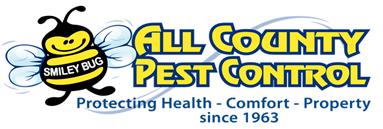The Norway rat (Rattus norvegicus, also called the brown rat or sewer rat) is a destructive pest found in urban and suburban neighborhoods. New York rats eat and contaminate food, damage buildings and other property by their gnawing and burrowing, and may spread diseases that affect people and pets. All County Pest Control offers rat control in Lagrangeville, Wingdale, Holmes, Nelsonville, Garrison, Putnam Valley, Yorktown, Purchase, Ardsley, Ryebrook, Mamaroneck and the surrounding areas in Dutchess, Putnam, and Westchester counties.
Recognizing rat Infestations
The presence of rats can be detected by droppings or evidence of fresh gnawing. Tracks can be seen in mud and on dusty surfaces. Runways and burrows may be found next to buildings, along fences or railroad tracks, and under low vegetation and debris.
Norway rats are husky, brownish rodents that weigh about 11 ounces. They are about 13 to 18 inches long including the 6 to 8 1/2 inch tail. Their fur is coarse and mostly brown with scattered black on the upper surfaces. The underside is typically grey to yellowish-white. Rats will eat nearly any type of food, but they prefer high-quality foods such as meat and fresh grain. Rats require 1/2 to 1 fluid ounce of water daily when feeding on dry food. Rats have keen taste, hearing and sense of smell. They will climb to find food or shelter, and they can gain entrance to a building through any opening larger than 1/2 inch across.
Rats have litters of 6 to 12 young, which are born 21 to 23 days after mating. Young rats reach reproductive maturity in about three months. Breeding is most active in spring and fall. The average female has four to six litters per year. Rats can live for up to 18 months, but most die before they are one year old.
Rat prevention and control
Sanitation. Poor sanitation and the presence of garbage help rats to survive in residential areas. Good sanitation will effectively limit the number of rats that can survive in and around the home. This involves good housekeeping, proper storage and handling of food materials and refuse, and elimination of rodent shelter (harborage). Outside dog pens must be properly maintained to reduce potential rat problems. Removing clutter around homes allows inspection for signs of rats. Good sanitary practices will not eliminate rats under all conditions, but will make the environment less suitable for them to thrive.
Rat-Proof Construction. The most successful and permanent form of rat control is to “build them out” by making their access to structures impossible. Ideally, all places where food is stored, processed or used should be rodent-proof. Store bulk foods, bird seed and dry pet food in metal cans with tightfitting lids.
Seal any openings larger than 1/4 inch to exclude both rats and mice. Openings where utility conduits enter buildings should be sealed tightly with metal or concrete. Equip floor drains and sewer pipes with tightfitting grates having openings less than 1/4 inch in diameter. Doors, windows and screens should fit tightly. It may be necessary to cover edges with sheet metal to prevent gnawing.
All County Pest Control has treating rats downs to a science. Rat infestations are one of the most common pest problems that we encounter. Most rat infestation originate from some major type of conducive condition on the outside subject property; bird feeders, compose pile, outdoor pets and dense overgrowth. All County will take all the care and precasutions when treating your home for rats. We will inform you of conducive conditions and potential entry points and make all necessary recommendations to eliviate the problem. All baiting applications will be in out of reach areas or contained within a tamper resistant bait station. All County uses bait blocks and packs as needed or required.

